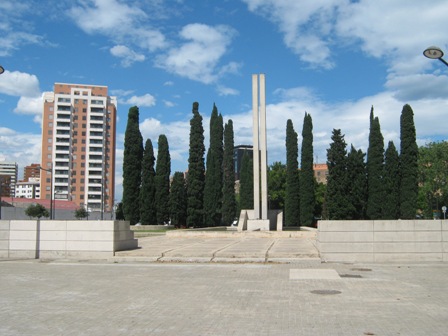Donations can be sent to the Spanish Red Cross by Bizum 33512 or SMS AYUDA 38092.
Càritas, the religious NGO has two bank accounts available:
Caixa Popular: ES 19 3159 0078 5716 6338 6025
Caixabank: ES02 2100 8734 6113 0064 8236
The following article was written before the October 2024 flood and is a history of flooding in Valencia. The humourous tone is probably inappropriate today.
Every time a drop of rain falls in Valencia and the water gently carresses the thighs, people start talking about never having seen anything like it before. And yet, at the risk of being tarnished as a negationist, or whatever, the truth is very different.
When I first arrived in Valencia, I thought this monument might be a homage to the Valencian coat hanger industry in imitation of Excalibur stuck into the ground by some angry customer. In fact it is supposed to be dedicated to the memory of those who perished during the flood of 1957, one that many older Valencians still remember to this day.
On the 13th of October of that year heavy rains of up to 300 litres per square metre fell in the basin of the River Turia. On the 14th the rains continued causing two flash floods to hit the city. The Turia flooded its banks at 2 in the morning and then again at midday after a brief respite, the levels of water reaching two metres in some parts of the city.
The river has its source near Albarracin in Teruel province and falls a total of 1,600 metres during its 280 kilometre descent to the sea.
It is a river that often barely deserves the name, but in epochs of heavy rains in Spring and Autumn it often swells and overflows its banks. These epochs of torrential monsoon-like rain are known as the “gota fria” (cold drop) by Valencians and although brief, are often considerably destructive.
Valencia was founded by the Romans in 138 B.C. and its history has been one of periodic flooding, although the double flooding of 57 is thought to have been the worst.
One of the earliest documented floods occurred in October 1321, followed by others in 1340 and 1358, the latter, following a drought, destroying all the city’s bridges and killing 400 people.
The flood of 1476 was attributed to the wrath of God and blamed on the sins of the people by many would-be prophets of the time, and another followed in 1487.
The flood of 27th September 1517 was especially violent, accompanied by hail, lightning and a lion-like roaring, causing hundreds of deaths, attacks of madness and the destruction of all the city’s mills. Many priests and monks kept up a permanent public prayer session calling upon the waters to recede. There were also many earthquakes recorded that year. The 16th century saw various floods in 1540, 46, 55, 57, 77, 81 and 89.
In 1964 the government started construction of a 12 kilometre long, 175 metre wide diversion channel, known as the ‘new river bed’ with a capability of discharging 5,000 cubic metres of water per second. The discharge during the flood of 57 was calculated at 3,800 cubic metres of water per second. The old river bed became the Turia Park where the City of Arts and Sciences now stands.
The monument, designed by Valencian sculptor Ramón de Soto Arándiga, was erected 25 years after the flood in 1982 in Avenida Aragon, so called because it was where the train line to Aragon used to begin.


